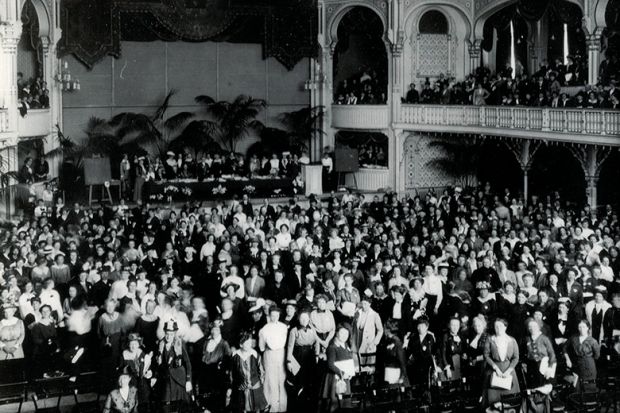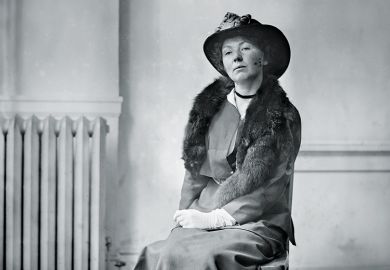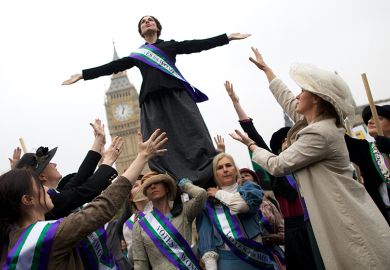In this, the centenary year of the Representation of the People Act, images of suffragettes and suffragists are popping up everywhere. In every photograph of Emmeline Pankhurst perched next to one of Landseer’s lions in Trafalgar Square, or of Millicent Fawcett proudly parading her “law-abiding” credentials in Hyde Park, the numerous women in the crowds appear anonymous, often more hat than face.
The iconic image from The Hague Women’s Peace Congress of 1915 (pictured above) that appears on the cover of Ann Oakley’s Women, Peace and Welfare is of this type. About 300 of the more than 3,000 “dangerous women” who overcame the near-insurmountable obstacles associated with unaccompanied travel through Europe, in wartime, to the congress, here look at the camera. Nearly all of the faces appear to be white; those ubiquitous hats are very much in evidence; and enormous ferns provide an incongruous background (the congress was held at The Hague’s zoo).
That we don’t know who so many of those blurry-faced women, and others like them, are – and that we are unlikely ever to find out – is what drives Oakley’s magnificent book. Generations of activist women have been lost “in the dark undergrowth of standard historical accounts” because “ways of forgetting are as thoroughly entangled with cultural values as are ways of knowing”.
Oakley comes at this project of retrieving female reformers from the “cobwebbed corners of historical basements” with a lifetime of remarkable research behind her. She’s written many non-fiction works and novels, including some cornerstones of feminist sociological theory such as The Sociology of Housework (1974) and Gender on Planet Earth (2002), where she scrutinised the ideological workings of The Family (deliberately adopting those capital letters to emphasise the ideologically enshrined stranglehold of unchallenged tradition).
The women whose stories Oakley tells in Women, Peace and Welfare, and whose work she acknowledges in some cases for the first time in more than a century, were, as the phrase goes, “bloody difficult women”. And that’s because they’re the ones who got things done. Many of them came to Oakley’s attention when she was working on her previous book, Father and Daughter (2014). That account of the life and work of the founder of the academic discipline of social policy, Richard Titmuss, Oakley’s deeply flawed father, was one of the bravest pieces of writing I’ve ever read. In Women, Peace and Welfare she picks up the story, recalling Titmuss calling two of his colleagues at the London School of Economics in the 1950s, Charlotte Towle and Eileen Younghusband, “difficult women”. It was a formative moment for the young Oakley, as it “stirred up a question or two for the future about what might really have been going on”.
Here she deliberately eschews detailed consideration of those women – the Pankhursts, for example, or Rosa Luxemburg – who are written about fairly comprehensively elsewhere, but even some of those women who I thought I did “know” – Charlotte Perkins Gilman, for example – come to life in new and vivid ways. Gilman was a woman born at least a century ahead of her time. Her magazine, The Forerunner, was devoted to issues of social reform, bridging “public issues and private concerns”, since, in Oakley’s words, “homes are the world’s business, and public politics must embrace the home”.
The women she writes about are history’s sleeve roller-uppers, hands-on activists, often from fairly privileged backgrounds, who witnessed and wanted to ameliorate the awful living conditions of the urban poor in the late 19th and early 20th centuries. Here, Oakley persuasively argues, we see the origins of a welfare state aligned with pacifism and laying the groundwork for modern social science research. This tripartite focus – welfare, anti-militarism and the development of a new academic discipline – appears irresistibly logical in her book, since we must “live in peace with one another” if we’re to have the welfare in place to ensure the rapid solution of “pressing social problems”.
The book is an act of excavation and reclamation, but also of reconstruction without sentimentality: “This was no idealized, universal, unproblematic sisterhood of transnationalism,” Oakley rightly states, “but a world of hard work and long drawn-out debates and conversations” before “air travel or telephones”. She listens to the women she features and shares their stories, positioning them unapologetically (why should one apologise when righting an egregious wrong?) back into social history and – crucially – into historiography, too.
Women, Peace and Welfare is a big, detailed book, which sets out to recalibrate the historiography of the social sciences; to reclaim suppressed voices; to provide pen portraits of forgotten women by metaphorically staring into those blurry faces that stare back at us from under those absurdly over-elaborate hats; and to map the emergence of social policies spearheaded by women that eventually led to the establishment of the welfare state.
By the author’s own admission, it is a gargantuan task. “Ever since I first realized I was writing a book about all this,” she admits at one point, “I’ve struggled with how to contain it.” On learning from a friend who read the manuscript that the lives and works of 351 women are considered (“I hadn’t dared to count them myself”), Oakley declares that she apologises “if this overcrowding produced headaches”. One way she tames her material is by creating a large appendix listing female reformers. It’s an impressive roll call, and the very act of saying or writing these women’s names is the first step in acknowledging their contributions.
Of those women whose lives are fleshed out in the main body of the book, I found myself drawn (as I suspect Oakley is, too – her enthusiasm for what these women achieved is infectious) to the erudite Vida Dutton Scudder, socialist follower of Ruskin. Her “friends joked that her real home was either the Middle Ages or the utopian future” and she was an early advocate and engineer of what became known as the “Settlement” movement, offering practical welfare support to working-class communities in London, and ultimately in the US.
Another trailblazer was Helena Swanwick, whose writing on gender and militarism inspired the Zurich meeting of the Women’s International Committee for Permanent Peace in 1919, at which there was something of a “Spartacus” moment as woman after woman raised her hands aloft, all national divisions and differences aside, to cry “We dedicate our lives to Peace!”
Beyond Europe, African American women such as Ida B. Wells were making extraordinary strides in the name of equality. Anna Julia Cooper, daughter of a slave, did research in the early 20th century into what would today be called intersectionality, but, as Oakley notes, “in the usual slight meted out to unusual women, commentators have subsumed her record under that of the nearest man – in this case W. E. B. DuBois”, who quoted Cooper’s work without attribution.
A similar slight affected another woman about whom I was delighted to learn. “A quarter of a century before Alfred Kinsey got round to it,” writes Oakley, the American criminologist Katherine Bement Davis published a longitudinal study that must surely have been seen by her colleagues in the late 1920s as both trivial (because it was specifically about women’s experiences) and taboo. Davis analysed the sex lives of more than 2,000 of her female contemporaries, finding that 61 per cent of her unmarried subjects reported that they masturbated, as did 38 per cent of her married ones.
The photographs that accompany the pen portraits in Women, Peace and Welfare are revealing in themselves: midwifery pioneer Annie McCall sits sternly in black suit and tie, while Alice Hamilton, world-leading toxicologist in the field of industrial health and safety, “looks clear-sightedly and wisely at you, as though she knows exactly who you are and what you’re up to”.
What Oakley is “up to” is the considerable task of finding an answer to her own heartfelt question: “Why did I emerge from 20 years of formal education believing that history was made by great men, with women watching, aproned, from the sidelines, occasionally murmuring a complaint about the doors that were closed to them?”
With books such as Oakley’s, there is simply no excuse for that to continue: change the state of affairs by writing women back into history, and affairs of state can, one hopes, only follow suit. This is the very best tool for that urgent endeavour.
Emma Rees is professor of literature and gender studies at the University of Chester, where she is director of the Institute of Gender Studies.
Women, Peace and Welfare: A Suppressed History of Social Reform, 1880-1920
By Ann Oakley
Policy Press
368pp, £30.00
ISBN 9781447332565
Published 8 March 2018
The author
Ann Oakley, professor of sociology and social policy at the UCL Institute of Education, was born in 1944 and brought up in west London – in what she describes as “a politically connected household which was notable for its emphasis on the injustices of class, but not those of gender”. She studied philosophy, politics and economics at Somerville College, Oxford and took the new sociology option in her final year. Although she initially wrote fiction after leaving university, she recalls, she later “found a way of combining writing with sociological research, which is more or less the story of my life since”.
Alongside her pioneering and highly influential works of feminist sociology starting with Sex, Gender and Society (1972), therefore, Oakley wrote novels such as The Men’s Room (1989), which became an acclaimed television series. “My research-based books and my novels often share the same themes,” she explains. “The difference is that the novels don’t have footnotes, but the invented characters in novels can offer a form of resistance to their creator’s plans, which is not unlike the constraints ‘real facts’ impose on non-fiction. Fiction has historically been a tremendously important source of information about social conditions.”
Asked about the ways the struggles described in her new book can inspire political activism today, Oakley responds that “major issues such as crime and violence (domestic, national and intra-national), the destruction of the environment, the lack of respect for the rights of majorities/minorities, including women and children, and the escalating inequalities between classes and social groups, all require a perspective that crosses conventional policy boundaries. The women in Women, Peace and Welfare were experts at lateral thinking. They saw, for example, that a society based on welfare for all must be a society that has abolished anti-social behaviour and warfare as responses to conflict.”
Matthew Reisz
Register to continue
Why register?
- Registration is free and only takes a moment
- Once registered, you can read 3 articles a month
- Sign up for our newsletter
Subscribe
Or subscribe for unlimited access to:
- Unlimited access to news, views, insights & reviews
- Digital editions
- Digital access to THE’s university and college rankings analysis
Already registered or a current subscriber?






